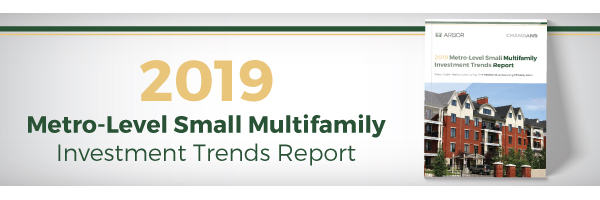Articles
Because single-family rental (SFR) properties tend to be located in the suburbs and away from public transportation hubs, the typical tenant drives to work. As a result, an area’s typical commuting time is a factor that is often weighed heavily by residents — impacting rental demand and pricing.
Current Reports
The small multifamily sub-sector ended 2022 on a high note with originations falling just behind 2021’s peak. As economic storm clouds continue circling, small multifamily appears fortified from any reverberations that may result.
Articles
Positive rent reporting, a new piece of Fannie Mae’s mission-driven lending agenda, is a leap forward for the U.S. rental housing market amid an ongoing affordability crisis. This initiative, recently launched in a pilot program in Chicago, has significant upside potential for not only tenants but landlords, owners, and multifamily borrowers as well.
Valuations Flatten as Cap Rate Start to Rise from Record Lows The small multifamily sub-sector ended 2022 on a high note with originations falling just behind 2021’s peak. As economic storm clouds continue circling, small multifamily appears fortified from any reverberations that may result. Key Findings: Small multifamily originations reached $80.7 billion in 2022, the highest annual total after 2021’s record high. Cap rates inch higher from record lows, ticking up to 5.1%. Debt yields rise and LTVs hold near post-pandemic lows as lending standards remain tight. Complete the form to instantly access the full report!
Articles
Passed in the 11th hour of the 117th Congress, the $1.7 trillion federal spending package prioritizes the expansion of affordable housing in 2023 through increased funding for targeted programs.
Special Reports
Special Report: Spring 2023 The rental housing sector is well-insulated but not immune to market forces even as the economy edges into correction territory, Arbor Chairman and CEO Ivan Kaufman and Chandan Economics Founder Sam Chandan demonstrate in the findings of Arbor’s Special Report Spring 2023. Key Findings: The sustainability of consumer financing and geopolitical tensions are risk factors capable of triggering an economic contraction more severe than baseline forecasts. Unlike other commercial property types, the market standard of amortizing mortgages will insulate the rental housing sector from expiring debt distress. The single-family rental and build-to-rent sectors should see structural gains despite cyclical headwinds as awareness for the product type grows and hybrid work supports a broader geography of housing choices for urban-working Americans.
Investment
The rental housing sector is well-insulated but not immune to market forces even as the economy edges into correction territory, Arbor Chairman and CEO Ivan Kaufman and Chandan Economics Founder Sam Chandan demonstrate in the findings of Arbor’s Special Report Spring 2023.
Articles
Until recently, full-scale optimization has skipped over the basic monthly rental payment transaction, with 78% of more than 100 million renters using paper checks. But now, two programs, backed by global leaders in financial services, are incentivizing tenants to pay the rent on credit, with perks like automatic credit reporting and points towards future purchases.











